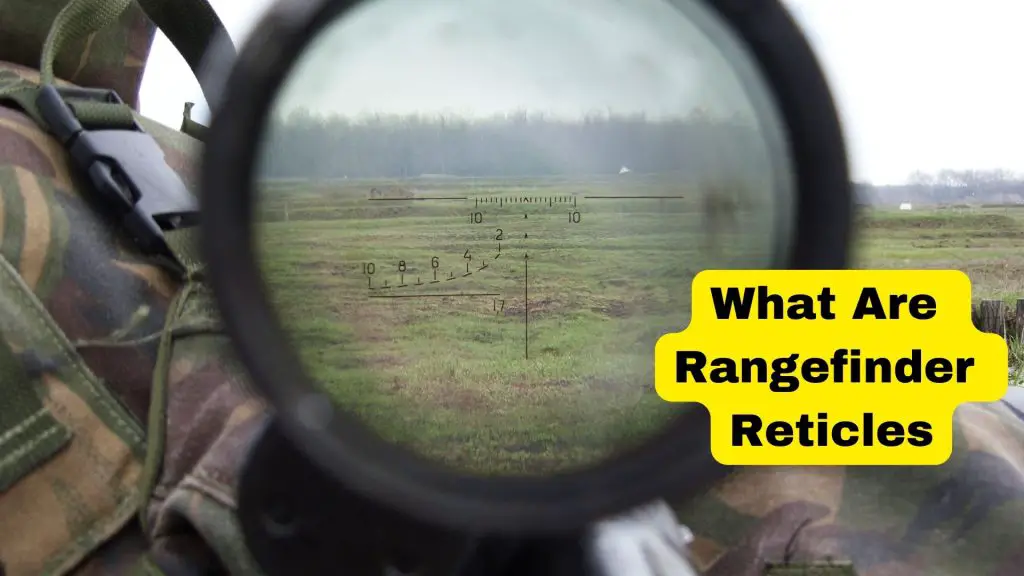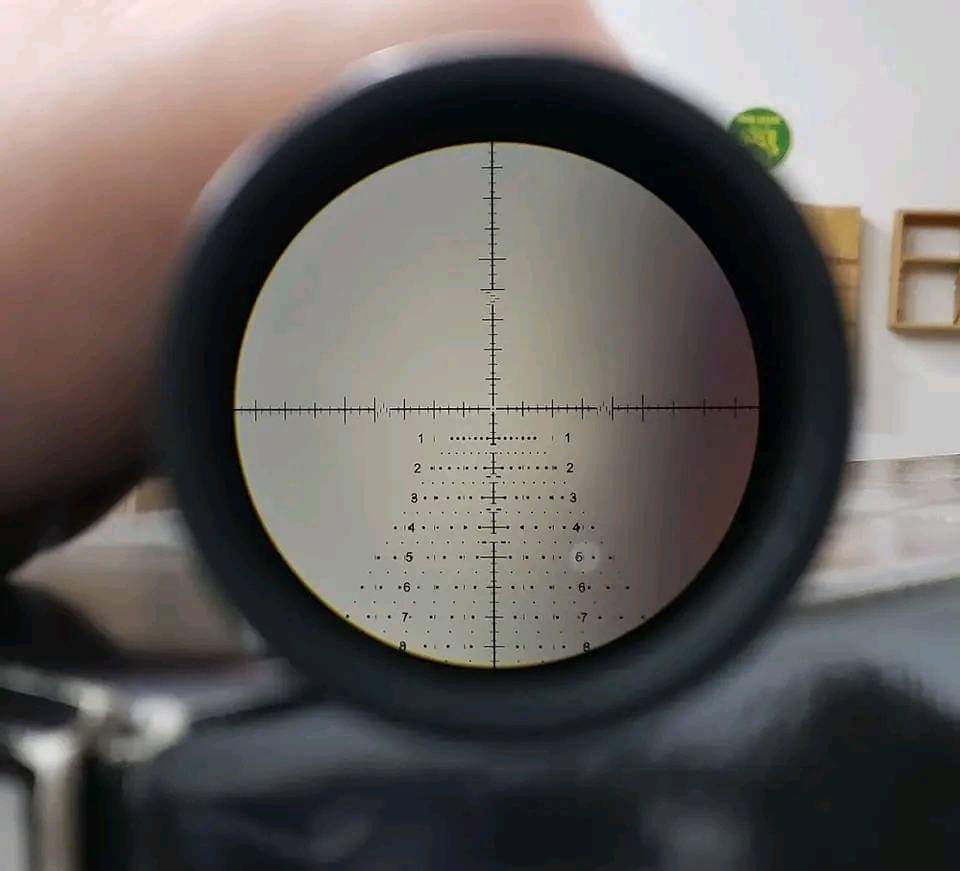What is a Rangefinder Reticle: How Do they work
Have you ever wondered how hunters, golfers, or sailors can estimate the distance to their targets with such accuracy? This is where rangefinder reticles come into play.
A rangefinder reticle is a special type of crosshair that is used to estimate the distance to a target. It consists of a set of markings that can be used to measure the size of a target in the reticle and, in turn, calculate the distance to that target.
But how exactly do rangefinder reticles work? In this topic, we will explore the science behind rangefinder reticles and how they are used in various real-world applications.

Source: Wikimedia
What Are rangefinder reticle
A rangefinder reticle is a type of reticle (the crosshairs or aiming point) used to estimate the distance between a person using the reticle and a target. This type of reticle typically consists of a series of brackets or circles that correspond to the size of a target at a known distance.
To use a rangefinder reticle, the user first estimates the size of the target in the reticle, then uses the known size of the target to estimate the distance.
Some rangefinder reticles also incorporate additional features, such as dots or hashes that correspond to specific ranges, or holdover marks that compensate for bullet drop at longer distances. These features can help the shooter make more accurate shots at longer ranges.
Where are Rangefinder Reticles Used?
Rangefinder reticles are commonly used in hunting and long-range shooting. They can help hunters and shooters quickly estimate the distance to their target, which is essential for making accurate shots at longer ranges.
In addition to hunting and long-range shooting, rangefinder reticles are also used in military and law enforcement applications. Snipers, for example, often use reticles that incorporate rangefinder features to help them estimate the distance to a target and make accurate shots.
How Do Rangefinder Reticles Work?
Rangefinder reticles work by using known dimensions of a target to estimate its distance from the shooter. The reticle typically includes brackets, circles, or other markings that correspond to the size of a target at a specific distance.
To use a rangefinder reticle, the shooter first estimates the size of the target in the reticle. They can then use the known size of the target to estimate its distance. I will show you in the next section how to use a rangefinder reticle in binoculars.
Some rangefinder reticles also include additional features, such as dots or hashes that correspond to specific ranges, or holdover marks that compensate for bullet drop at longer distances. These additional features can help the shooter make more accurate shots at longer ranges.
It’s important to note that rangefinder reticles are not as precise as laser rangefinders or other dedicated range-finding tools. However, they can still provide a quick and effective way to estimate distance in the field, especially for hunters and shooters who need to make quick shots at varying distances.

Formula and Real Situation on How Rangefinder Reticles Work
The formula for using rangefinder reticles to estimate range is:
Distance to Target (in yards) = Target Size (in yards) x 1000 ÷ Size of Target in Reticle (in mils)
Here’s a real-life situation that illustrates how rangefinder reticles work:
Let’s say you are a hunter out in the field and you spot a deer. You estimate that the deer is about 2 feet tall (or 0.67 yards) and you have a rifle scope with a rangefinder reticle that has a mil dot spacing of 1.0 mils. When you look through the scope, you notice that the deer is about 2.5 mils tall in the reticle. To estimate the distance to the deer, you can use the formula above:
Distance to Target = Target Size x 1000 ÷ Size of Target in Reticle
Distance to Target = 0.67 x 1000 ÷ 2.5 = 268 yards
So, in this example, you would estimate that the deer is approximately 268 yards away.
It’s important to note that rangefinder reticles require the shooter to estimate the size of the target in the reticle, which can be challenging in the field. Additionally, the accuracy of the estimation depends on the consistency of the size of the mil dots in the reticle and the shooter’s ability to make accurate estimates.
Check the below video to learn better about distance estimation:
Rangefinder reticles vs Laser Rangefinders
Rangefinder reticles are typically less accurate than laser rangefinders, but they can be quicker to use and do not require batteries or electronics. Rangefinder reticles are also less expensive than laser rangefinders and can be a good option for hunters and shooters on a budget.
Laser rangefinders, on the other hand, use lasers to measure distance to a target. They are typically more accurate than rangefinder reticles and can provide precise measurements in a matter of seconds. Laser rangefinders can also be used in low light conditions and can range targets at longer distances than rangefinder reticles.
In general, if you need precise and accurate distance measurements, laser rangefinders are the better choice. However, if you need a quick and easy way to estimate distances and do not want to rely on batteries or electronics, a rangefinder reticle can be a good option. Ultimately, the choice between rangefinder reticles and laser rangefinders depends on your specific needs and budget.
Rangefinder Reticle: Real-World Applications
Rangefinder reticles have a variety of real-world applications, particularly in outdoor activities such as hunting, shooting, and long-range target shooting. Here are some examples of how rangefinder reticles can be used in these activities:
- Hunting: A rangefinder reticle can be used to estimate the distance to a target animal in the field. This is particularly useful when hunting in terrain where distances are difficult to judge. The hunter can use the rangefinder reticle to estimate the distance to the animal, which can help them make an accurate shot.
- Shooting: Rangefinder reticles can also be useful in shooting competitions or practice sessions. By using the rangefinder reticle to estimate the distance to the target, the shooter can adjust their aim and make more accurate shots.
- Long-Range Target Shooting: Rangefinder reticles are particularly useful for long-range target shooting, where distances can be challenging to judge. By using a rangefinder reticle in combination with a ballistic calculator, shooters can make more accurate shots at long distances.
- Search and Rescue: Rangefinder reticles can also be used in search and rescue operations. For example, a rescuer can use a rangefinder reticle to estimate the distance to a stranded hiker or climber, which can help them determine the best approach for the rescue.
- Golf: Rangefinder reticles can also be used in golf to estimate distances to the hole or other features on the course. Golfers can use rangefinder reticles on specialized golf rangefinder to estimate the distance to the hole or other targets on the course.
Range Finder Reticles in Marine Binoculars
Marine binoculars with rangefinder reticles can help boaters and sailors estimate the distance to other boats, landmarks, or navigational aids such as buoys or lighthouses.
By estimating the size of the target in the reticle and using the formula for rangefinder reticles, boaters can determine the distance to the target and make more informed navigational decisions. This can be especially important in situations where visibility is limited, such as in fog or at night.
In addition, some marine binoculars come with rangefinder reticles that are specifically designed for marine applications. These reticles may have different markings or scales to help boaters estimate distances more easily and accurately.
Conclusion
While laser rangefinders have become increasingly popular in recent years, rangefinder reticles remain a reliable and cost-effective alternative. They do not require batteries, are more lightweight, and can be used in a wider range of conditions.
Whether you are a seasoned hunter, avid golfer, or experienced sailor, understanding how rangefinder reticles work can help you move to your target closer.
